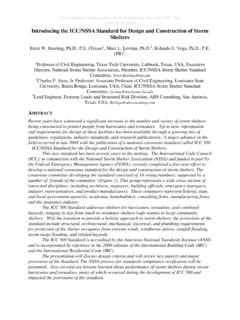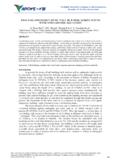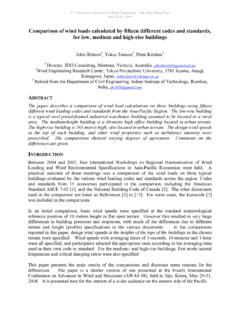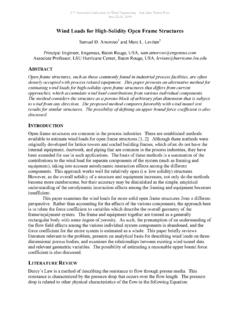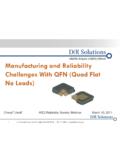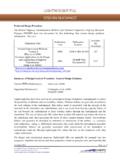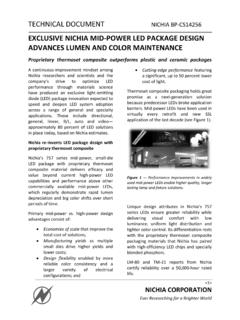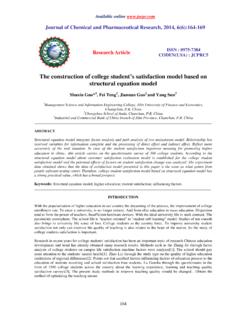Transcription of Design Wind Speeds for Mexico: An optimum …
1 Design wind Speeds for Mexico: an optimum approach of wind Design of structuresCelso J. Mu oz Black1, Jorge S nchez Sesma2, Alberto L pez L pez3 and Luis E. P rez Rocha41 Researcher,CivilEngineering Department,Instituto de Investigaciones El ctricas, Cuernavaca,Morelos, M Instituto Mexicano de Tecnolog a del Agua, Cuernavaca, Morelos, M Department,Instituto de Investigaciones El ctricas, Cuernavaca,Morelos, M Department,Instituto de Investigaciones El ctricas, Cuernavaca,Morelos, M structural wind Design that has been a common practice in mexico , is based onregional maximum gust wind velocities of specific return periods associated with differentstructural importance or accepted risks.
2 However, nowadays it is a matter of controversy tospecify the optimum return periods to Design different type of structures against wind effects thatconduct to minimum cost of losses in case of a structural failure. Although, wind hazarddistribution in mexico has been well studied, transmission line failures are still occurring,mainly due to hurricane into account theimportantdirect and indirect lossesdueto lifeline structural failures occurred recently in mexico , a research study focused on thebalance between the costof lossesand the structural reliabilitylevel has been practice based on optimal criteriona well established optimum Design model, whichis usual forseismic Design in mexico , is now being implemented.
3 Described in thispaper is anew optimum wind Design model, as well as a sensitivity analysis of the involved , conventional and optimal gust wind velocity maps were developed and are presentedand discussed in this work for practical the last twenty three years, a unified designcriteria for the determination of windpressures on high voltage transmission systems and structures, has been developed forMexico[1,2,3]. The Design wind determination procedure was based on annual maximum gusts arisingfrom a detailedterrain and topography homogenization followed by anextreme probabilisticanalysis of wind Speeds registered in different meteorological stations located all over maximum wind speed estimations were made also considering specificallyhurricane winds.
4 Following this procedure, different isotach maps for predefined return periodsof 10, 50, 100 and 200 years, considering the importance of the structural system, have beenupdated[4].On the other hand, although wind hazard distribution in mexico has been well studied,transmission line failures are still occurring mainly due to hurricane winds like occurred inMexico during 2005and 2007 ( Wilma in 2005,Lane in 2006 and Dean in 2007),whichcaused important damages and losses to transmission structures linesas shown in Figures 1 into account all these facts mentioned above,theMexican Electrical Utility (CFE,as perSpanish abbreviation)
5 Focused its interest on developing different research studies in orderto improve their wind Design process both for wind reliability and also for risk analysisformulation. The first of these studies was devoted to update thedistribution of wind hazards forMexico [4], taking advantage of the improved methodologies for the estimation of hurricane andorography effects and completing the wind Speeds database up to 2006. Figure 3 shows theisotach map for return period of 50 years, which is normally associated to structures of mediumimportance level. The second study was focused to the balancebetween the cost and thestructural reliability level, allowing for the relevance of the optimal criterion based Design .
6 Forthis, a well recognized optimum Design criterion,initially applied for seismic regionalization ofthe Mexican territory [5, 6], was implemented in order to define the best return period for whichimportant facilities and life line structures must be designed againstwind actions with minimumtotal 1:Damage caused by hurricane Wilmain Cancun(2005)Figure 2:Damages caused by hurricane Lanein 2006 Figure 3: Isotach map for return period of 50 years updated in 2006 OPTIMALDESIGN OFWINDRESISTANCESTRUCTURESIn thecase ofoptimal Design ofwind resistancestructures, it is recognized that the cost ofdiscriminating between feasible Design alternatives, is the total cost involved during the structureservice life which integrates not only its initial construction and operating costs, but the futureexpected costs, the last ones being related to upkeep expenses, for example, repairs, maintenanceand replacement of losses caused by services interruption.
7 Fatalities and injuriesand other consequences of failure or damage, are commonly added to indirect economicexpected costs. In many facilities, for example in electrical transmissions systems, the mostimportant expected cost involved is due to electrical service interruption when severe failuredamage is presented in one or more times in its service the optimum Design formulation it is assumed that all these costs are dependent on asingle parameter: the nominal resistance Design , which is expressed in terms of wind pressureover an exposed area. Then, a parameter of Design is optimal if it minimizes the amount ofpresent value of the total costs of a structure or a system.
8 As a result, optimal values are notassociated with constant return periods. Indeed, the optimization leads to a situation that isintuitively a Design rule: in areas of low wind danger, where a structure Design against windactions is relatively cheap, the Design is an optimum for return periods higher than those thatwould be used in areas of greater the present study, the methodology proposed in the pioneering work by Esteva[6],initially applied for seismic regionalization of the Mexican territory, has been followed to findoptimal wind velocities for Design . According to this document, it is considered that a variable ofdesign is optimal if it minimizes the amount of expected costs from the decision of usingprecisely that value the following paragraphs, the two components of the total cost ofa structure during itsservice life are following variation for the initial construction cost,)(vCI, is adopted, 00000if)(if)(vvvvCCvvCvCIR (1)Where.
9 VWind speed for structural Design ,0vWind speed that the structure should resist if it has not been designed againstwind actions,0 CStructure cost even if this is not designed to withstand lateral wind loads, andRC, Constants of the initial cost the Equation 1 is normalized with respect to0C, we have: 0000if)(1if1)(vvvvKvvCvCI (2)Where, evidently,0 CCK/R .EXPECTEDLOSSESCOSTAs a proposed wind loss model, it is assumed that each time the Design speed ,v, isexceeded, it will provide a total loss cost of the structure. This model is obviously too real resistance of a structure is, in general terms, uncertain but has an average resistancehigher than the nominal resistance that arises when adopting a value of speed Design .
10 Thus, whenthe nominal Design wind speed is exceeded, not necessarily a total loss is presented, and can onlybe given a probabilistic estimation on the value of the loss. Moreover, it is conceivable that evenif the demand does not exceed the nominal wind speed Design , partial failures are presented. Thiswould require the development of functions of vulnerability and its formal inclusion in thecalculation of the , the optimization process was carried out only to determine relative levels ofexpected costs between structures in different parts of the country. Because of this, it wasconsidered that the use of a more refined model would not achieve substantial to Rosenblueth[7], if it is assumed that wind hazard follows a Poissonprocess, and if the updated value of money is properly described by an exponential function, thepresent value of the expected losses,)(vEVP, when a structure is designed to resist the windspeed v , is: )()()(vvCPvEVP (3)Where.
